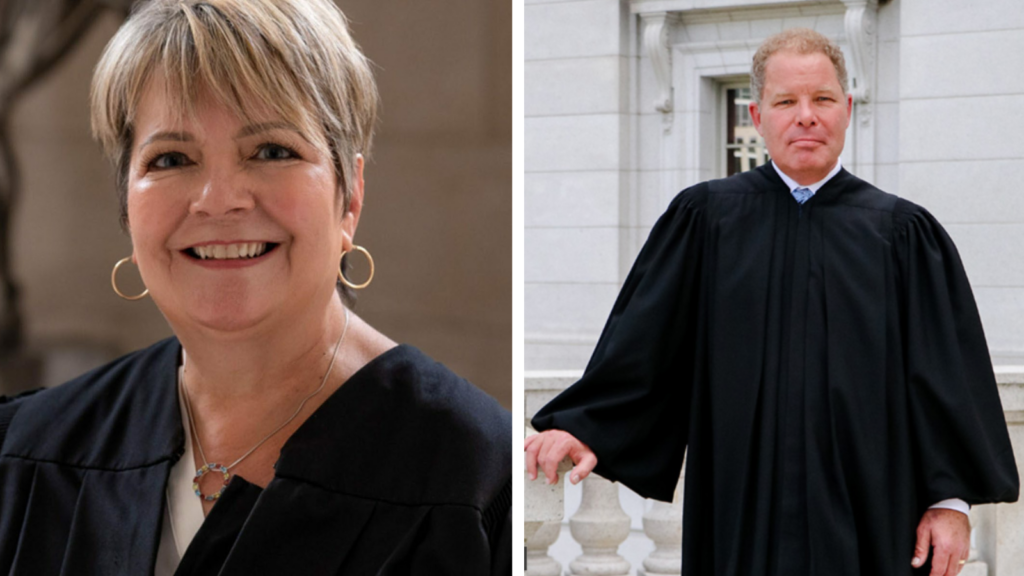Abortion access, voting district maps and executive powers all hang in the balance.

This analysis was originally published by The Brennan Center.
On April 4, Wisconsin will hold an election for a seat on its state supreme court, which has had a clear conservative majority since 2008. Two candidates—judicial conservative Daniel Kelly and progressive Janet Protasiewicz—have advanced out of a four-way primary and are vying to replace a retiring conservative justice. The election, which has already broken records for spending and primary turnout, represents liberals’ first chance in a decade to break the conservative lock.
Media accounts say Wisconsin’s high-profile supreme court election is primarily about two issues: abortion and gerrymandering. That’s true, but the race also tells a broader story about the influence state courts are wielding in the face of divided government and eroding federal rights.
The political and legal landscapes—both in Wisconsin and nationally—have changed dramatically in the 15 years that conservatives have controlled the court. A Republican sweep in 2010 allowed the state legislature and governor to adopt gerrymandered maps that locked in Republican legislative control for the next decade. When Democrat Tony Evers won the governor’s race in 2018, he stalled the Republican agenda by issuing a record-breaking number of vetoes. The state supreme court has stepped into the void, choosing sides in balance-of-power disputes and resolving significant questions in areas ranging from election administration to public health.
At the same time, the U.S. Supreme Court has retreated on abortion rights and partisan gerrymandering, relegating both questions to the states. In Wisconsin, where abortion is unavailable and the legislative maps are still heavily skewed, lawsuits on both fronts are likely to land before the state’s high court—especially if it shifts to the left.
In short, purple state politics and headwinds on federal rights, coupled with the rare chance to flip the state supreme court’s ideological balance, have converged to create a perfect storm for this April’s election. The Wisconsin Supreme Court is resolving issues that federal courts and the state’s political branches can’t (or won’t) tackle. Abortion access, electoral maps and executive powers all hang in the balance.
Abortion
April’s judicial election is likely to dictate the fate of abortion in Wisconsin.
In Wisconsin, as in eight other states, a pre-Roe law prohibiting nearly all abortions was never formally repealed, though it was unenforceable for nearly half a century. This 1849 law, adopted just one year after statehood, prompted Wisconsin providers to stop offering abortions last year when the Dobbs decision eliminated abortion rights under the U.S. Constitution.
A lawsuit brought by Wisconsin’s attorney general asserts that this revived law was superseded when the legislature adopted new statutes regulating abortion during the Roe era. In a second claim, the attorney general invoked the rarely used doctrine of desuetude to argue that the 19th-century statute sat dormant for too long to be enforceable.
The case, now at the trial level, is expected to reach the state supreme court sometime after a new justice is seated. With endorsements indicating that the candidates stand on opposite sides of the abortion debate—and Protasiewicz explicitly staking out her pro-choice values—April’s judicial election is likely to dictate the fate of abortion in Wisconsin.
Abortion access is advancing toward a judicial resolution because the other branches are deadlocked. The attorney general’s legal theories of implied repeal and desuetude would be irrelevant if new legislation were enacted. But that’s unlikely to happen: The Democratic governor has vowed to veto any Republican bill that would retain the existing ban while adding exceptions for rape and incest. If the pending lawsuit succeeds and the 1849 law is struck down, abortion would again be permitted under the state’s Roe-era statutory framework.
Partisan Gerrymandering
The Wisconsin Supreme Court already resolved a political impasse over redistricting last year. But that case did not result in politically fairer maps. Instead, in a 4–3 decision, the court directed the parties to propose maps reflecting the “least change” necessary to comply with the law, using the previous decade’s “sharply partisan” maps as its starting point. The dissent said this elevated “outdated partisan choices over neutral redistricting criteria.”
Ultimately, following a trip to the U.S. Supreme Court, the Wisconsin Supreme Court adopted the same Republican-designed legislative districts that Evers had vetoed. The resulting maps reflect the most extreme partisan bias for any court-adopted map in the country going back at least two decades. Indeed, Republicans fared even better under the new maps than they had last decade. Although Evers won reelection by a “Wisconsin landslide” of 3.4 percent last November, Republicans came within three seats of a two-thirds legislative supermajority.
The resulting maps reflect the most extreme partisan bias for any court-adopted map in the country going back at least two decades.
The April election may be the last opportunity this decade to address gerrymandering in Wisconsin. If Protasiewicz prevails, the Wisconsin Supreme Court’s new liberal majority is expected to be receptive to new litigation that would challenge the current maps.
Although four justices concluded last year that the Wisconsin Constitution does not establish a right to partisan fairness, the three dissenters characterized that as an “advisory opinion” on an issue not squarely before the court. A new lawsuit could pose that question directly or advance another legal theory (described in more detail here).
Balance of Power
In the four years since Evers was elected, the conservative-leaning court has regularly intervened in power struggles between the political branches, most often ruling against the executive. When the legislature held a lame duck session to limit executive powers before Evers was inaugurated, the court concluded that the state constitution allows such extraordinary sessions, and it mostly upheld the lame duck laws the legislature adopted.
Early in the pandemic, the court invalidated the health secretary’s stay-at-home order and enjoined an executive order that would have delayed the state’s April 2020 judicial election and presidential primary. The court also constrained the governor’s appointment authority by allowing a Republican to remain on a state board past the end of his term, and it limited the governor’s partial veto power when it invalidated three such vetoes while upholding a fourth.
Meanwhile, the court has largely upheld controversial laws enacted during the state’s eight years of unitary Republican control. In 2014, the court concluded that the state’s voter ID law does not impose an additional elector qualification or unconstitutionally burden the right to vote. The court also rejected a challenge to Act 10, a 2011 law that severely curtailed collective bargaining for public employees.
In other cases, the court has ruled against local governments and officials who ran afoul of the state’s Republican leadership: terminating county prosecutors’ investigation into campaign coordination, invalidating Milwaukee’s residency requirement for city employees, and holding Madison’s mass transit weapons ban preempted by a state concealed carry law.
Whether a liberal majority would revisit any of these decisions is difficult to predict, but Republicans have sounded the alarm about that possibility. What’s clear is that April’s election represents a reckoning not only on abortion and gerrymandering but on this divided state’s balance of power more broadly.
Up next:
U.S. democracy is at a dangerous inflection point—from the demise of abortion rights, to a lack of pay equity and parental leave, to skyrocketing maternal mortality, and attacks on trans health. Left unchecked, these crises will lead to wider gaps in political participation and representation. For 50 years, Ms. has been forging feminist journalism—reporting, rebelling and truth-telling from the front-lines, championing the Equal Rights Amendment, and centering the stories of those most impacted. With all that’s at stake for equality, we are redoubling our commitment for the next 50 years. In turn, we need your help, Support Ms. today with a donation—any amount that is meaningful to you. For as little as $5 each month, you’ll receive the print magazine along with our e-newsletters, action alerts, and invitations to Ms. Studios events and podcasts. We are grateful for your loyalty and ferocity.





